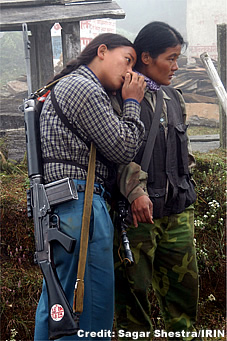
|
| Reports on Nepal's Civil War: Landmines |
|
|
|
|
|
| Activists urge more government action on de-mining |
Kathmandu, 13 August 2007 (IRIN)
 |
|
Chitrakar said the government needs to come up with a concrete plan on de-mining, and support victims.
A decade-long armed conflict, which killed over 14,000 people, ended with the November 2006 peace agreement between former Maoist rebels and the Nepalese government.
One of the key agreements was to destroy all IEDs and landmines within 60 days of its signing, but eight months later none of the 53 minefields has been cleared, said activists.
Committees formed
 |
|
Activists frustrated
Activists are frustrated over the lack of government action and concerned that too many people are living near landmines and IEDs.
"Explosions are taking place even now in civilian areas and the number of casualties is shockingly high," said Chitrakar.
According to UNICEF, which serves as Nepal's mine action focal point, there were at least 79 new victims, including 35 children, in 2007. Around 13 of them were killed, it said. The number of incidents was very high for a country in which armed conflict had ended, it added.
Mapping has been completed for landmines and UNICEF has so far provided 3,500 mine hazard signs at 53 minefields but finding all the IEDs is proving more difficult. It is these that are the main killers of civilians, according to various non-governmental organisations (NGOs).
IEDs kept in private houses
"We need maximum cooperation from civilians, otherwise the campaign will not work," UNICEF's bomb risk specialist Hugues Laurenge told IRIN. He expressed concern that a lot of IEDs were still lying around in private houses.
People are tempted to keep the IEDs to blast rock to create space for housing or road construction. Some also keep IEDs as souvenirs, activists said.
In May, nine civilians were killed in Palpa District, about 250km west of Kathmandu, after a bucket bomb hidden in a house by a local villager blew up.
Both
the UN and government are now actively involved in educating civilians
about landmines and IEDs but activists said more work needs to be done.
The government has so far been able to train 330 police as mine-risk educators.
top
Copyright © UN Office for the Coordination of Humanitarian Affairs 2007
[ This report does not necessarily reflect the views of the United Nations]
Integrated Regional Information Networks (IRIN), part of the UN Office for the Coordination of Humanitarian Affairs (OCHA).

|
